The Clarkdale Review: Intel's Core i5 661, i3 540 & i3 530
by Anand Lal Shimpi on January 4, 2010 12:00 AM EST- Posted in
- CPUs
Intel HD Graphics: A Lot Better
With Clarkdale Intel has finally dropped the Graphics Media Accelerator (GMA) prefix. Intel integrated graphics is now just called Intel HD Graphics.
The move to 45nm gave Intel the ability to beef up its graphics core a bit, but ultimately it’s the same architecture as the G45 - just faster. We won’t see Larrabee on a CPU for some years to come.
The GMA X4500 core from G45 had 10 shader processors. Intel HD Graphics bumps that up to 12. Apparently there are a number of internal tweaks and performance enhancements that should result in more than a 20% increase in performance though.

All integrated GPUs regardless of vendor, pretty much suck. Intel gets a bum rap because while other IGPs may offer 30+ fps in games at the lowest quality settings, Intel can often only manage single digit frame rates. It doesn’t take too much searching to prove that one.
Clarkdale does change that a bit. Intel has finally delivered an integrated graphics solution that is at least competitive with existing IGPs on the market. To show you how far it’s come I’ve pitted our Clarkdale based Core i5 661 against an AMD Phenom II X4 965 with 790GX graphics. Our 790GX platform had 128MB of on-board memory to drive performance even higher. If Intel can manage a win here, it'll be a convincing one.
I’ve also tossed in a G45 board for good measure. The only absent member is NVIDIA's GeForce 9400. We found in our 790GX review that AMD delivered roughly the same graphics performance (if not better) as the 9400 so any advantage/disadvantage here would apply to NVIDIA as well.
We’ll start off with Batman: Arkham Asylum. This is an Unreal Engine 3 based game. The first thing you need to remember about integrated graphics is that regardless of the game, you’ll want to go in and turn down every single quality setting at your disposal. In this case I ran Batman at 1024 x 768 with all quality options set to low.

That's Batman running on Intel HD Graphics
Batman doesn’t look half bad at the playable IGP settings. It’s surprising. Tim Sweeney once told me that a good looking game is half engine, half art. It looks like Batman just has that right combination of engine and art to make it look decent even on Intel’s integrated graphics. It’s not great by any means, but it’s not pixelated mush.
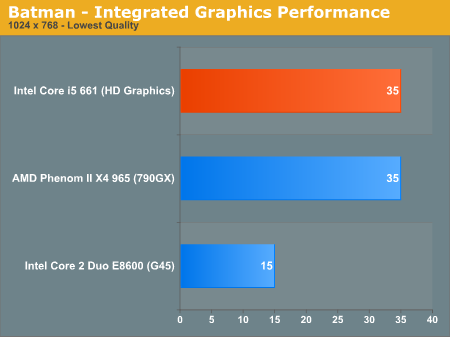
The performance is also halfway respectable. Intel’s fastest integrated graphics manages to tie AMD’s 790GX IGP at 35 fps. It’s also over twice as fast as G45. Even the lower end Core i3 CPUs should manage close to 30 fps here.
Next up is Dragon Age. Unfortunately, this game doesn’t look as good at its playable integrated graphics settings. It ends up looking like 3D Kings Quest played on a PS2.
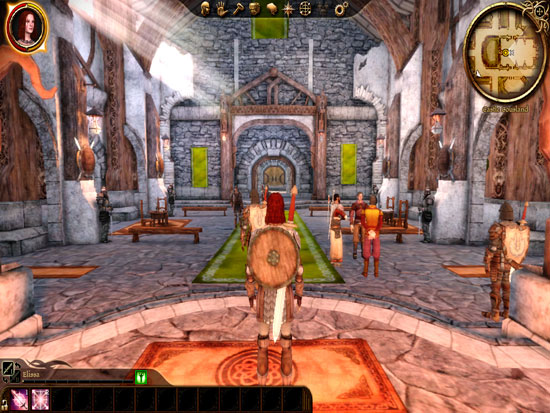
Giggle.

Performance is respectable from the new Intel HD graphics. At 41.5 fps it’s actually faster than AMD’s 790GX chipset. Definitely more than twice the speed of the old G45. Keep in mind that we’re looking at the highest end IGP from Intel. The Core i3s will be appreciably slower, most likely at or below the performance of the 790GX.
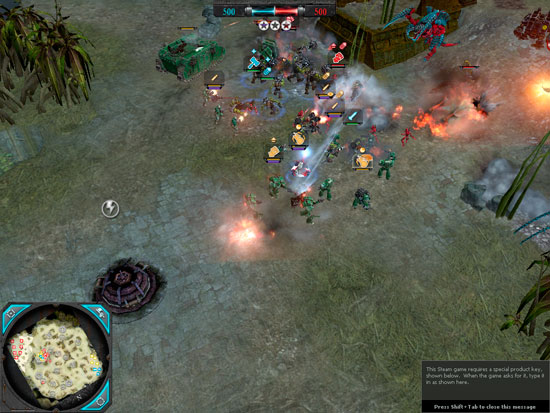
Dawn of War II on Intel HD Graphics
Dawn of War II looks and plays like crap on Intel’s integrated graphics. Averaging 15 fps on the fastest Clarkdale, the minimum frame rates dropped as low as 3.4 fps. This is a huge improvement over G45, but definitely not what I would consider playable.
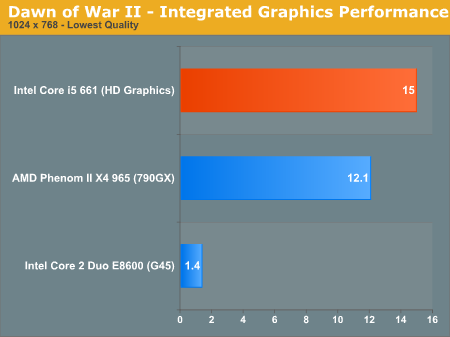
Intel is technically the leader here though. AMD’s 790GX only managed 12.1 fps. IGPs need not apply for this title at present.
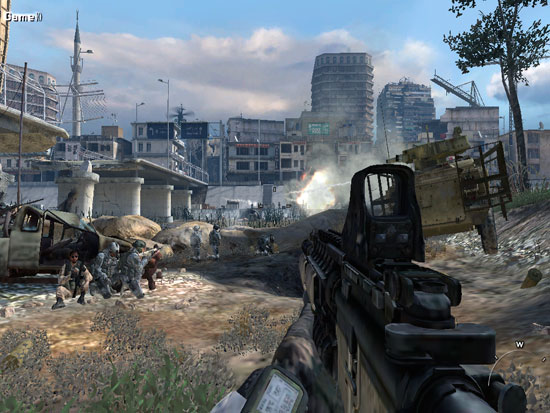
Call of Duty Modern Warfare 2 is the first time that we see Intel losing. The game loses much of its visual appeal at the settings you need to run at in order to be playable on integrated graphics, especially on a larger screen.
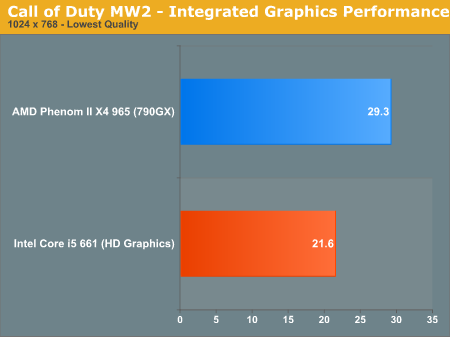
AMD’s 790GX is around 40% faster than Intel’s HD Graphics. Blech.
World of Warcraft is a very important title to perform well under and unfortunately Intel loses this one to AMD. However, we are running at the "Good" setting as opposed to bare minimum detail settings:
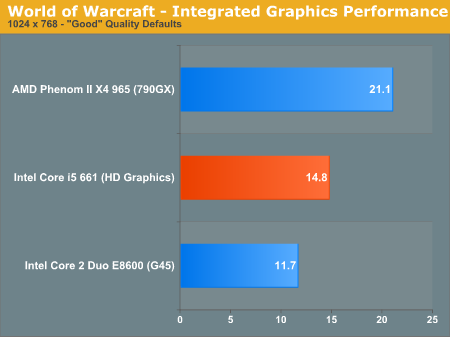
Our final integrated graphics game benchmark is HAWX.

At 53 fps Intel falls behind the 790GX but it’s around 2x the speed of G45 and high enough that I’d consider it playable (albeit at the lowest possible settings).
Intel has taken a significant step forward with its integrated graphics. It's at the point where I'd say it's finally competitive with the best from AMD or NVIDIA. Intel has delivered on its promise to take integrated graphics more seriously, and I hope we will see even bigger performance gains with Sandy Bridge.
Intel took a big step forward to the point where it is no longer the laughing stock of the graphics industry. But it stepped into a position of mediocrity, joining AMD and NVIDIA. Integrated graphics has never been good regardless of the manufacturer. We honestly need to be at around 2x existing performance to deliver a reasonable gaming experience on integrated graphics. AMD is going to be shipping its 8-series chipsets later in the year and perhaps that will change things.
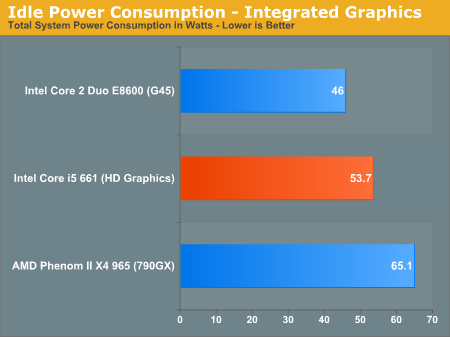
Despite the 45nm on-package GPU, the Core i5 661 actually draws more power at idle than the old G45 with an E8600. It's still much more power efficient than the equivalent from AMD. If you're building something with integrated graphics, you want it to be a Clarkdale.
To test power consumption under load I fired up a 1080p x264 video using Media Player Classic Home Cinema and measured total system power consumption:
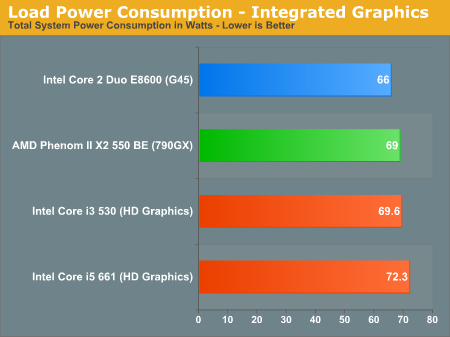
A CPU swap and some tweaking later and our AMD power consumption numbers now make sense. While playing H.264 encoded video the GPU does all of the heavy lifting and there's no power advantage for Clarkdale to rest on. When watching a movie the AMD system is indistinguishable from our Clarkdale test bed.










93 Comments
View All Comments
SydneyBlue120d - Tuesday, February 9, 2010 - link
The Intel G9650 doesn't exist, what You're referring is Intel G6950http://ark.intel.com/Product.aspx?id=43230">http://ark.intel.com/Product.aspx?id=43230
puterfx - Wednesday, February 3, 2010 - link
I've been building systems since the late 90's, mostly for others, and I'm always the last to get a decent system so I decided it was about time for me. I'm running an e6600 on a 3 yr old Intel board w/ 2g of DDR2 RAM and was wondering about the differences between C 2 quad, i3-540, i5-750 or i7-820. I priced out 3 different setups with Gigabyte boards (EP45, H57 & P55 - USB3 ver.) combined with Q8400/9300/9400 on EP45, i3-540,i5-750 and i7-820 on the H57 & P55 and 4 Gb DDR3 RAM (Crucial, Geil, Kingston)so , basically, I had 9 combinations. Excluding the i7, the price range for these builds was about $429 - $487, and I could probably do better if I tried but I was amazed that they were that close (the i7 adds another $100 but not that much improvement in performance that I can see).Looking at your charts, I think I can justify going with the i5-750. I have a decent video card for the occassional gaming that works pretty good for me now (I'll apply the $100 from above to a better card later) but I do a lot of spreadsheets and some photoshop and autocad so I think I'll see a better improvement there.
Thanks again for all your articles. Very well written, understandable and thorough.
KingAlexander - Saturday, January 30, 2010 - link
I too am puzzled by the i7 870 scoring so low on the World of Warcraft chart -- it stood out to me immediately when I first read the article. I was a little surprised to not see it mentioned.It was suggested in another comment that this was due to the game having an issue with hyperthreading, but if that was the case shouldn't the i7 920 also have scored significantly lower than it did?
Bloodx - Monday, January 25, 2010 - link
It should be noted that this new intel system does not workat 1080p/24 correct. The nvidia 9400 chipset works at 1080p/24.
So i've traded audio for skipping.
HTPC is no better off. Sad.
geok1ng - Sunday, January 10, 2010 - link
Previous Intel IGPs managed achieve less terrible numbers in game by cheating- they didn't render all the polygons and textures. So for good measure i require side by side screenshots of the "new, better, faster and cheaper" Intel IGP.The idea of an Intel IGP that simply isn't horrible is SOO strange that a true review would have to go the race: benchmarks, screenshots, minimum playable settings for various games and screenshots. Something the articles on HardOCP.
snakyjake - Wednesday, January 6, 2010 - link
Why isn't the i7-860 tested in the section "Windows 7 Application Performance"?Without the i7-860 in the Windows 7 test section, this review is pointless.
NeBlackCat - Wednesday, January 6, 2010 - link
I was hoping to build a new always-on home server around one of these. Power miserly IGP and idle operation (for when it's only firewalling and routing) but plenty of grunt in reserve for occasional video encoding, compiling and running virtual machines.Looks like they missed the mark for this application, and I couldn't even adopt now and wait for the real deal CPU later, as the socket is a dead end.
IMHO only the HTPC crowd have a reason to be excited here, but there are lots of other (cheaper) ways to get low power 1080p too.
ruetheday - Friday, January 8, 2010 - link
Let's wait and see - There are products coming which will do gpu assisted transcoding that might shift things in Clarkdale's favor.bongbong - Tuesday, January 5, 2010 - link
I know for a fact that the athlon II x3s and x4s have to overclock like crazy in games to reach the same performance delta as their phenom II x3 and x4 brethren(coz of the 6mb cache and many games are dependent on cache)
Ive seen gaming benchmarks on anandtech where the x3 720 matched the x4 965 when they are both overclocked to 3.8ghz.
I was able to buy an x3 720 for only a 110 usd recently.
So why isnt it in the benchmark comparisons?
JohnMD1022 - Tuesday, January 5, 2010 - link
$150 from microcenter.